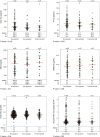Prodromal characteristics of dementia with Lewy bodies: baseline results of the MEMENTO memory clinics nationwide cohort
- PMID: 35854388
- PMCID: PMC9295361
- DOI: 10.1186/s13195-022-01037-0
Prodromal characteristics of dementia with Lewy bodies: baseline results of the MEMENTO memory clinics nationwide cohort
Abstract
Background: Isolated subjective cognitive impairment (SCI) and mild cognitive impairment (MCI) are the prodromal phases of dementia with Lewy bodies (DLB). MEMENTO is a nationwide study of patients with SCI and MCI with clinic, neuropsychology, biology, and brain imaging data. We aimed to compare SCI and MCI patients with symptoms of prodromal DLB to others in this study at baseline.
Methods: Participants of the French MEMENTO cohort study were recruited for either SCI or MCI. Among them, 892 were included in the Lewy sub-study, designed to search specifically for symptoms of DLB. Probable prodromal DLB diagnosis (pro-DLB group) was done using a two-criteria cutoff score among the four core clinical features of DLB. This Pro-DLB group was compared to two other groups at baseline: one without any core symptoms (NS group) and the one with one core symptom (1S group). A comprehensive cognitive battery, questionnaires on behavior, neurovegetative and neurosensory symptoms, brain 3D volumetric MRI, CSF, FDG PET, and amyloid PET were done.
Results: The pro-DLB group comprised 148 patients (16.6%). This group showed more multidomain (59.8%) MCI with slower processing speed and a higher proportion of patients with depression, anxiety, apathy, constipation, rhinorrhea, sicca syndrome, and photophobia, compared to the NS group. The pro-DLB group had isolated lower P-Tau in the CSF (not significant after adjustments for confounders) and on brain MRI widening of sulci including fronto-insular, occipital, and olfactory sulci (FDR corrected), when compared to the NS group. Evolution to dementia was not different between the three groups over a median follow-up of 2.6 years.
Conclusions: Patients with symptoms of prodromal DLB are cognitively slower, with more behavioral disorders, autonomic symptoms, and photophobia. The occipital, fronto-insular, and olfactory bulb involvement on brain MRI was consistent with symptoms and known neuropathology. The next step will be to study the clinical, biological, and imaging evolution of these patients.
Trial registration: Clinicaltrials.gov , NCT01926249.
Keywords: Dementia with Lewy bodies; Lewy body disease; Mild cognitive impairment; Mild neurocognitive impairment; Prodromal; Subjective cognitive impairment.
© 2022. The Author(s).
Conflict of interest statement
F.B. was the national coordinator for France for the Eisai Delphia (E2027) and Axovant Headway-DLB therapeutic trials; he is currently the national coordinator for France of the Roche Graduate therapeutic trial; he had received honoraria from Roche, Eisai, and Biogen for oral presentations. The other authors declare that they have no competing interests.
Figures



References
-
- Fujishiro H, Iseki E, Nakamura S, Kasanuki K, Chiba Y, Ota K, et al. Dementia with Lewy bodies: early diagnostic challenges. Psychogeriatrics. 2013;13(2):128-38. - PubMed
-
- Postuma RB, Iranzo A, Hu M, Hogl B, Boeve BF, Manni R, Oertel WH, Arnulf I, Ferini-Strambi L, Puligheddu M, et al. Risk and predictors of dementia and parkinsonism in idiopathic REM sleep behaviour disorder: a multicentre study. Brain. 2019;142(3):744–759. doi: 10.1093/brain/awz030. - DOI - PMC - PubMed
Publication types
MeSH terms
Associated data
LinkOut - more resources
Full Text Sources
Medical
Miscellaneous

